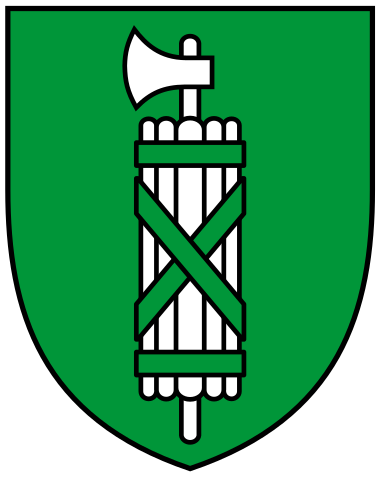What the “Axe/Raft Mix” Is

Hi!
In Wednesday’s Now I Know, I made a reference to the image above– the coat of arms of the Canton of St. Gallen, Switzerland. I said that St. Gallen “has adopted a new [design] over the last few centuries; its new coat of arms, seen here, is some sort of axe/raft mix on a green background.” A few of you wrote in to say I wrote “it’s” when I should have written “its.” Thanks for that. A lot more of you wrote to tell me what the “axe/raft mix” is. It’s called a “fasces,” and it has a really interesting story.
(A quick aside, though: given the political conversation in America right now, this may feel a little political, but it’s really just a coincidence. I didn’t know what the symbols was before Wednesday.)
Wikipedia describes the symbol, generally, as “a bound bundle of wooden rods, sometimes including an axe (occasionally two axes) with its blade emerging.” It dates back to the Etruscans, an ancient Italian civilization and, again per Wikipedia, actual sets of faces were used as a “portable kit for flogging and decapitation.” Over time, the fasces became a symbol of strength and resolve. A single rod is easy to break, but a bound group of them is rather resilient, after all. And the word itself underscores this; “fasces” comes from the Latin word for “bundle,” suggesting that unity brings strength. If you look at the Lincoln Memorial, you’ll see that on either side of Abe Lincon, there’s a pair of decorations on either leg of the chair, and they resemble fasces.

But that’s not the interesting part. As you’ve probably guessed, Italian fascism — and fascism generally — borrows its name from the fasces. And Benito Mussolini adopted it as part of his party’s symbolism going into and throughout World War II. Mussolini allied his nation with Nazi Germany, and society has outright rejected the inclusion of any Nazi symbolism going forward, even if historically, it wasn’t associated with evil. The fasces, which clearly were used before Mussolini (Lincoln predates him by a half-century), aren’t tainted, though. You’ll still see it today used by legitimate governments everywhere; for example, a pair of fasces appears on the bottom of the seal of the United States Senate, as seen here.
I don’t have a great explanation why nor would I dare to guess; I just learned that these things even had a name 48 hours ago. But as this newsletter is called “Now I Know,” well, now I know what this axe/raft mix is called and some history behind it. So I figured I’d share the above.
The Now I Know Week in Review
Monday: Children of the Box: How Finland helps keep babies thriving.
Tuesday: The Glow-in-the-Dark Watches That Also Killed People: The good news? It’s really cool looking. The bad news? It’s radioactive!
Wednesday: The Almost-War Over a Bear’s Missing Privates: The story of a bear’s missing you-know-what.
Thursday: The Wisdom of Crowds of Sports Fans?: A great baseball story that’s not really about baseball. By the way, LGM!
And some other things you should check out:
Some long reads for the weekend.
1) “‘Man of the Hole’: Last of his tribe dies in Brazil” (BBC, 5 minutes, August 2022). A few years ago, I shared a story about a tribe of five people in Brazil, and how it was likely going to die out. I think this is the story of a similar tribe of indigenous people — people who also, similarly, never industrialized — except that it was a tribe of one person. Until last month, that is. For this tribe, August 2022 marked the end of its history.
2) “Real Money, Fake Musicians: Inside a Million-Dollar Instagram Verification Scheme” (ProPublica, 20 minutes, August 2022) If your social media account is verified, that should mean you’re a real person. But as this investigation shows, that’s not always the case, and there’s money to be made if you’re able to fake it until you make it.
3) “The Twisted Life of Clippy” (Seattle Met, 12 minutes, August 2022). The backstory behind Microsoft Office’s much beloved — and oft-maligned — mascot-slash-virtual assistant.
Have a great weekend!
Dan
